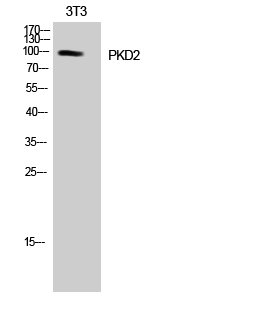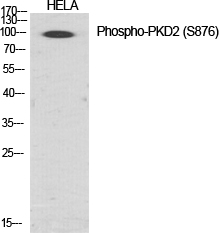
Catalog: YP0341
Size
Price
Status
Qty.
200μL
$600.00
In stock
0
100μL
$340.00
In stock
0
50μL
$190.00
In stock
0
Add to cart


Collected


Collect
Main Information
Target
PKD2
Host Species
Rabbit
Reactivity
Human, Mouse, Rat
Applications
WB, IHC, IF, ELISA
MW
96kD (Observed)
Conjugate/Modification
Phospho
Detailed Information
Recommended Dilution Ratio
WB 1:500-1:2000; IHC 1:100-1:300; ELISA 1:40000; IF 1:50-200
Formulation
Liquid in PBS containing 50% glycerol, 0.5% BSA and 0.02% sodium azide.
Specificity
Phospho-PKD2 (S876) Polyclonal Antibody detects endogenous levels of PKD2 protein only when phosphorylated at S876.The name of modified sites may be influenced by many factors, such as species (the modified site was not originally found in human samples) and the change of protein sequence (the previous protein sequence is incomplete, and the protein sequence may be prolonged with the development of protein sequencing technology). When naming, we will use the "numbers" in historical reference to keep the sites consistent with the reports. The antibody binds to the following modification sequence (lowercase letters are modification sites):RIsVL
Purification
The antibody was affinity-purified from rabbit antiserum by affinity-chromatography using epitope-specific immunogen.
Storage
-15°C to -25°C/1 year(Do not lower than -25°C)
Concentration
1 mg/ml
MW(Observed)
96kD
Modification
Phospho
Clonality
Polyclonal
Isotype
IgG
Related Products
Antigen&Target Information
Immunogen:
The antiserum was produced against synthesized peptide derived from human PKD2 around the phosphorylation site of Ser876. AA range:829-878
show all
Specificity:
Phospho-PKD2 (S876) Polyclonal Antibody detects endogenous levels of PKD2 protein only when phosphorylated at S876.The name of modified sites may be influenced by many factors, such as species (the modified site was not originally found in human samples) and the change of protein sequence (the previous protein sequence is incomplete, and the protein sequence may be prolonged with the development of protein sequencing technology). When naming, we will use the "numbers" in historical reference to keep the sites consistent with the reports. The antibody binds to the following modification sequence (lowercase letters are modification sites):RIsVL
show all
Gene Name:
PRKD2
show all
Protein Name:
Serine/threonine-protein kinase D2
show all
Other Name:
PRKD2 ;
PKD2 ;
HSPC187 ;
Serine/threonine-protein kinase D2 ;
nPKC-D2
PKD2 ;
HSPC187 ;
Serine/threonine-protein kinase D2 ;
nPKC-D2
show all
Database Link:
Background:
The protein encoded by this gene belongs to the protein kinase D (PKD) family of serine/threonine protein kinases. This kinase can be activated by phorbol esters as well as by gastrin via the cholecystokinin B receptor (CCKBR) in gastric cancer cells. It can bind to diacylglycerol (DAG) in the trans-Golgi network (TGN) and may regulate basolateral membrane protein exit from TGN. Alternative splicing results in multiple transcript variants encoding different isoforms. [provided by RefSeq, Jul 2008],
show all
Function:
Catalytic activity:ATP + a protein = ADP + a phosphoprotein.,enzyme regulation:Activated by diacylglycerol and phorbol esters.,Function:Calcium-independent, phospholipid-dependent, serine- and threonine-specific protein kinase.,PTM:Autophosphorylated. Phorbol esters stimulates autophosphorylation. Phosphorylation of Ser-876 correlates with the activation status of the kinase.,similarity:Belongs to the protein kinase superfamily.,similarity:Belongs to the protein kinase superfamily. CAMK Ser/Thr protein kinase family. PKD subfamily.,similarity:Contains 1 PH domain.,similarity:Contains 1 protein kinase domain.,similarity:Contains 2 phorbol-ester/DAG-type zinc fingers.,tissue specificity:Widely expressed.,
show all
Cellular Localization:
Cytoplasm . Cell membrane . Nucleus . Golgi apparatus, trans-Golgi network . Translocation to the cell membrane is required for kinase activation. Accumulates in the nucleus upon CK1-mediated phosphorylation after activation of G-protein-coupled receptors. Nuclear accumulation is regulated by blocking nuclear export of active PRKD2 rather than by increasing import. .
show all
Tissue Expression:
Widely expressed.
show all
Research Areas:
>>Rap1 signaling pathway ;
>>Aldosterone synthesis and secretion ;
>>Chemical carcinogenesis - reactive oxygen species
>>Aldosterone synthesis and secretion ;
>>Chemical carcinogenesis - reactive oxygen species
show all
Signaling Pathway
Reference Citation({{totalcount}})
Catalog: YP0341
Size
Price
Status
Qty.
200μL
$600.00
In stock
0
100μL
$340.00
In stock
0
50μL
$190.00
In stock
0
Add to cart


Collected


Collect
Recently Viewed Products
Clear allPRODUCTS
CUSTOMIZED
ABOUT US
Toggle night Mode
{{pinfoXq.title || ''}}
Catalog: {{pinfoXq.catalog || ''}}
Filter:
All
{{item.name}}
{{pinfo.title}}
-{{pinfo.catalog}}
Main Information
Target
{{pinfo.target}}
Reactivity
{{pinfo.react}}
Applications
{{pinfo.applicat}}
Conjugate/Modification
{{pinfo.coupling}}/{{pinfo.modific}}
MW (kDa)
{{pinfo.mwcalc}}
Host Species
{{pinfo.hostspec}}
Isotype
{{pinfo.isotype}}
Product {{index}}/{{pcount}}
Prev
Next
{{pvTitle}}
Scroll wheel zooms the picture
{{pvDescr}}



















